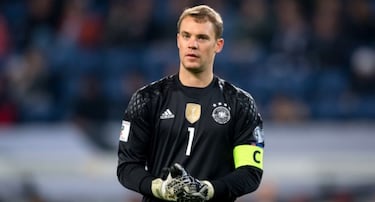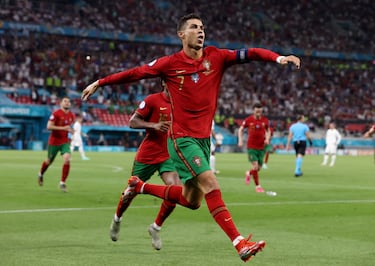From 1 to 11: What do jersey numbers in soccer historically mean?
While some jersey numbers have retained their historical significance, others have changed as football - especially tactics - has developed

If you’ve taken a look down the squad lists and numbers for the 2022 FIFA World Cup, how many of you have been stopped in your tracks through by a certain player’s number which just feels plain ‘wrong’?
Those of us who feel that way are probably showing our age a little but it’s a feeling that is hard to shake.
Ecuador’s Pervis Estupiñan is going to wear number 7? But he’s a left-back. Marcos Acuña of Argentina, also a left-back, has been given the number 8 jersey. What’s going on there? And who gave Gavi Spain’s number 9 jersey? Wait a moment, he’s not a centre-forward.
For those of us of a certain vintage, the numbers from 1 to 11 are associated with certain positions, which stems from the pre-1990s when squad numbers – and names on the back of the shirt – largely didn’t exist.
Number 1
There’s not too much to say here, as number 1 has always been traditionally worn by a goalkeeper and still is. As you might expect, there have been a few exceptions. Former Netherlands midfielder Edgar Davids gave himself the number 1 jersey when he was player-manager of English lower league club Barnet, while Argentina adopted a policy of assigning shirt numbers alphabetically in the 1978, 1982 and 1986 World Cups, which meant midfielders Beto Alonso and Osvaldo Ardiles and forward Sergio Almirón wore it in those tournaments respectively.

Number 2
Moving into defence, number 2 would be the starting defender on the right-hand side of defence, particularly in a defensive line of four. This is still often the case nowadays but, as with all of the other numbers on this list, it has become less common. For instance, while right-backs Kyle Walker (England) and Sergiño Dest (USA) will wear the ‘correct’ number in Qatar, centre-backs Antonio Rüdiger of Germany and José María Giménez of Uruguay have also been given the number 2 shirt.
Number 3
Switching over to the left-hand side of the field, number 3 would always have been the team’s left-back, a role which has become more and more attacking as time has gone on and tactics have changed. A number of teams at the 2022 World Cup have assigned the number 3 jersey to a centre-back – Diego Godín (Uruguay), Matthijs De Ligt (Netherlands), Eric García (Spain), Walker Zimmerman (USMNT).
Number 4
Depending on where you came from, number 4 would either be one of two central defenders in a back four (Virgil van Dijk of the Netherlands, Raphaël Varane of France, Pau Torres of Spain, Marquinhos of Brazil) or a defensive-minded midfielder (England’s Declan Rice, Mexico’s Edson Álvarez, USMNT’s Tyler Adams).

Number 5
For many, number 5 is associated with the other centre-back position. Think Jan Vertonghen of Belgium, John Stones of England or Johan Vasquez of Mexico. However, in many other countries, especially in Latin America, number 5 was often the more defensive-minded central midfielder, a trend which we can see in many 2022 World Cup squads (Argentina’s Leandro Paredes, Costa Rica’s Celso Borges, Spain’s Sergio Busquets, Brazil’s Casemiro).
Number 6
If a team’s centre-back was number 4, the chances are that one of their central midfielders wore number 6, and vice versa. Centre-backs Stefan De Vrij (Netherlands), Harry Maguire (England) and Andreas Christensen (Denmark) will wear number 6 in Qatar, as will midfielders Yunus Musah (USMNT), Axel Witsel (Belgium) and Joshua Kimmich (Germany).
Number 7
The most iconic number in football? Or does that come a little later in the list? In the United Kingdom, this was traditionally a right-sided midfielder in a 4-4-2 system or a right-winger in a 4-3-3. However, there are also lots of historical examples of forward players wearing this shirt number. Football systems and numbering have developed to such an extent that in the 2022 World Cup, most number 7s will be central midfielders (Kevin De Bruyne of Belgium, Rodrigo De Paul of Argentina, Lucas Paquetá of Brazil) or forwards who either play centrally or out wide (Portugal’s Cristiano Ronaldo, Spain’s Álvaro Morata, France’s Antoine Griezmann).
Number 8
Traditionally, the other of the two central midfielders. This player would often be described as a ‘box-to-box’ or ‘all-round’ midfield player (think prime Steven Gerrard), a role which has become increasingly less common as tactics have developed. As such, there are few players who fit this profile at the 2022 World Cup, although Jordan Henderson of England, Weston McKennie of the USMNT, Aurélien Tchouaméni of France and Leon Goretzka of Germany play this role to a certain extent and will wear number 8 at the tournament.

Number 9
Related stories
The number every kid wanted to wear when they first got into soccer, which may well not be the case now. The team’s main goalscorer who grabs all the headlines and gets paid the big money. England’s Harry Kane, Mexico’s Raúl Jiménez, Poland’s Robert Lewandowski and Belgium’s Romelu Lukaku will all hope to be that man for their nations in Qatar.
Number 10
The other contender for football’s most iconic number. In certain countries, number 10 was often another centre-forward, while in others, it was a team’s creative hub in the attacking part of the field, which would be closer to the modern-day association. A number of teams around world football would consider their number 10 to be their key offensive player and that will also be true at the 2022 World Cup (Lionel Messi of Argentina, Sadio Mané of Senegal, Christian Pulisic of USMNT, Kylian Mbappé of France, Luka Modrić of Croatia, Neymar of Brazil).
Number 11
Traditionally a left-sided attacking player, either on the left of a midfield four or of a front three. Again, another number that is now often used for attacking players of different types, who are capable of playing a variety of different roles in the final third (France’s Ousmane Dembéle, Spain’s Ferran Torres, Argentina’s Ángel Di María, Wales’ Gareth Bale).

